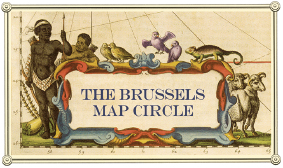Mapping Africa
Tervuren, Belgium
- 10.00 – 10.30 - Welcome visitors with coffee
- 10.30 – 10.45 - Absurd Mistakes and Blunders … by Prof. Dr. Imre Demhardt
Although the ancient Mediterranean cultures knew the northern edge of Africa and the Portuguese uncovered its coastal outlines in the fifteenth century, the geography and history of the hinterlands remained rumoured about but seriously explored only since the late eighteenth century. After sketching the physical geography and introducing to post-discovery history of the African landscape, the presentation will focus on the colonial partition and drawing of boundary lines in the nineteenth century, the pivotal period to the modern map of the continent. - 10.45 – 11.00 - A Short Overview of Printed Maps of Africa from 1501 to 1800 by Prof. Em. Elri Liebenberg
Ever since the Portuguese rounded the Cape of Good Hope and reached India in 1498 the map of Africa has undergone various changes. The first map of the continent which represented the shape of Africa reasonably correct was the Cantino Planisphere of 1502. This presentation will give a short overview of printed maps of Africa from 1501 to 1800 by referring to three of the six key characteristics Richard Betz mentions in his seminal book entitled The Mapping of Africa (2007):- the depiction of the shape of the continent
- information on the hydrography (the lakes and river systems)
- the depiction of mountain ranges
- 11.00 - 11.15 - Questions and answers ans short break
- 11.15 – 11.45 - Sisyphus in the Desert: The Strange Story of the Unfinished Map Series of German South West Africa, 1892-1918 by Prof. Dr. Imre Demhardt
It was not before the second half of the nineteenth century that serious commercial and missionary interest for South West Africa took off. These explorations resulted in route and basic overview maps of a rugged and, for the most part, only sparsely populated region. The need for more detailed mapping arose with the Scramble for Africa, when German merchant Adolf Lüderitz in 1883 bought Angra Pequena, one of only two natural harbours on that coast. Along with subsequent acquisitions this nucleus was declared the Protectorate of German South West Africa, the first and soon most important German colony in Africa. After establishing the boundaries and succeeding in pacifying the indigenous communities, colonial penetration and valorisation was only possible based on topographical knowledge. The presentation will introduce highlights from the most active period in cartographic coverage of southwestern Africa, but also try to explain why the famed Preußische Landesaufnahme [Prussian Survey] failed to conclude any but one (large scale) series – and why this torso still was unsurpassed until the 1970s … - 11.45 – 12.15 - The Cartography of the South African Diamond Fields, 1871 to 1876 by Prof. Em. Elri Liebenberg
It has long been known that South Africa is a leading producer of high-quality gem diamonds and that diamonds have played an important role in the history of the country. This presentation will deal with the cartography involved in the struggle for the possession of the diamond fields and how a doctored map was used by the British Government to expropriate the diamond fields from the legitimate ownership of the Orange Free State in 1873 and to annex the area then called Griqualand West as British territory. Attention will also be given to the territorial disputes which continued and the eventual settlement with the Free State of 1876. - 12.15 - 12.30 - Questions and answers
- 12.30 – 14.30 - Lunch in the Museum Bistro (optional and paying; EUR 52.00 for a three course menu with drinks; to be paid on site)
- 14.30 – 17.00 - Exploring Africa with Ancient Maps. In the afternoon, a selection of maps from the collection of the Museum will be presented by Wulf Bodenstein, volunteer curator of this collection, author of Exploring Africa with Ancient Maps, (2017 – also available in French and Dutch translations) and founder of the Brussels Map Circle. This viewing of the maps will take place in alternating groups, to ensure good visibility of the maps to all. While waiting their turn to see the maps, participants are free to visit the newly refurbished museum at their leisure as they will be given a free entrance ticket for the museum for the day. Beside the two famous wall maps of the Belgian Congo, they can discover some of its 27 collections covering various facets of Central Africa, from pre-history until current day life: ethnography, history, art, religion and traditions, landscape and biodiversity, mineralogy, music, etc.
Free for Members.
Accompanying persons and non-Members are invited to pay EUR 20.00 on our bank account IBAN BE52 0682 4754 2209 | BIC: GKCCBEBB and to mention in the bank transfer 'Tervuren 2019' and the name of the person.
Useful links Registration
If you would like to join this event please register here.
